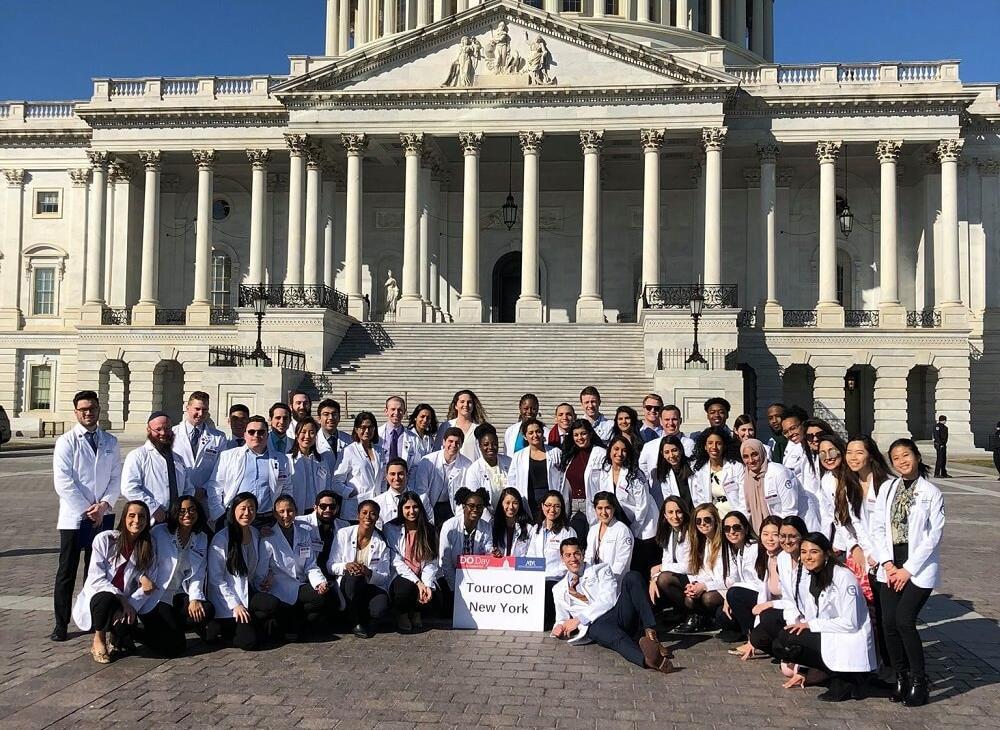A Thousand White Coats on Capitol Hill
TouroCOM Harlem Sends 75 Students to DO Day on the Hill

On March 4, 75 TouroCOM Harlem medical students hopped on to two coach buses to explore another element of the medical profession: advocacy.
The students journeyed to Washington, DC, as part of DO Day on Capitol Hill, an annual lobbying and advocacy effort organized by the American Osteopathic Association (AOA) and the Student Osteopathic Medical Association (SOMA).
“It’s cool to take a step back from studying and see other avenues where you can influence medical treatment from a political standpoint,” said Connor Bailey, outgoing president of TouroCOM Harlem SOMA’s chapter who helped organize the trip. “A lot of things that influence how we can practice and who we can treat are determined at the legislative level. It’s important to see the decision-making process—how things change and more importantly, how to bring about change.”
The group stayed overnight at a hotel and then rose before five in the morning the next day to attend the day’s briefing on the issues that the students would be advocating for. Lobbying focused primarily on two proposals: Direct Primary Care legislation, where patients pay a monthly fee to primary care physicians—lobbying focused specifically on allowing patients to pay the monthly fee through HSA accounts; and reauthorizing and refunding the Teaching Health Centers Graduate Medical Education program, a community-based medical residency training program that places residents in rural communities and other areas without adequate medical care.
“Having residencies in these areas is especially important to us as DO’s,” explained Bailey. “Often when students finish their residencies in those areas, they end up staying there and continuing to practice. It’s a program that can have really beneficial effects for improving medical outcomes.”
“If you practice in a rural location you are more likely to stay and take care of your patients,” said Abbey Santanello, president-elect of SOMA. “The primary care shortage is in these rural areas and having funding for placing residents there will really help that.”
Students visited the representatives from where they were registered to vote. (Bailey, who hails from Arizona, visited representatives from that state, while Santanello, from Ohio, spoke to legislative aides to Senators Sherrod Brown and Rob Portman.)
“It was an amazing experience,” said TouroCOM Harlem student Harmanjit Khokar. “A lot of people aren’t familiar with what DO’s do and this was an opportunity to go out there and tell people who we are and what we want to do.”
Bailey and Santanello said that TouroCOM had the largest student delegation and credited the school for sponsoring the accommodations and transportation.
“The symbolism of the day was very important,” said Santanello. “1,000 students in their white coats walked around Capitol Hill. People stopped us on the street to ask what we were advocating for and it was a moment to share our message about what we plan to do as DO’s.”
“It gives us a peek inside the life of a healthcare advocate in Washington,” added Bailey. “The truth of the matter is that not all medical school graduates are going to end up practicing. Some of us will turn to politics and it’s hard to get exposure to the political side of the equation. DO Day gives us an insight into what it would be like.”
After a full day of lobbying, students boarded the buses to return to Harlem and get some rest before Wednesday’s classes began.

